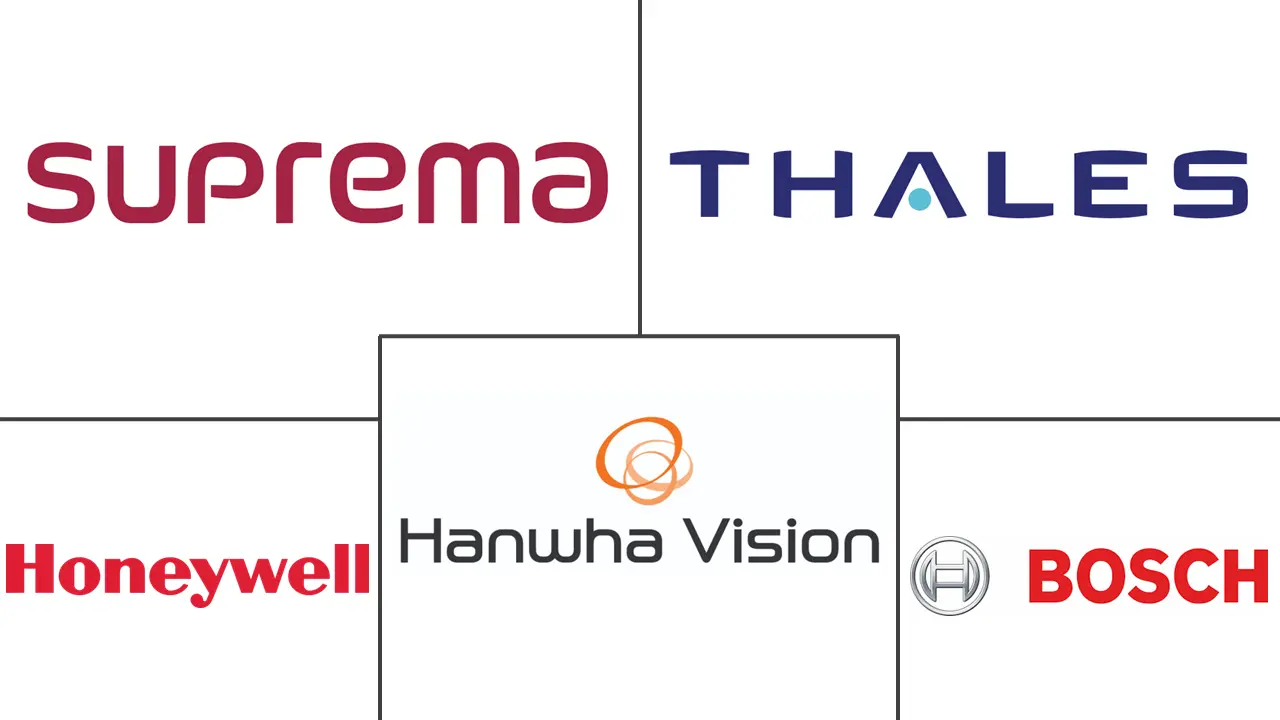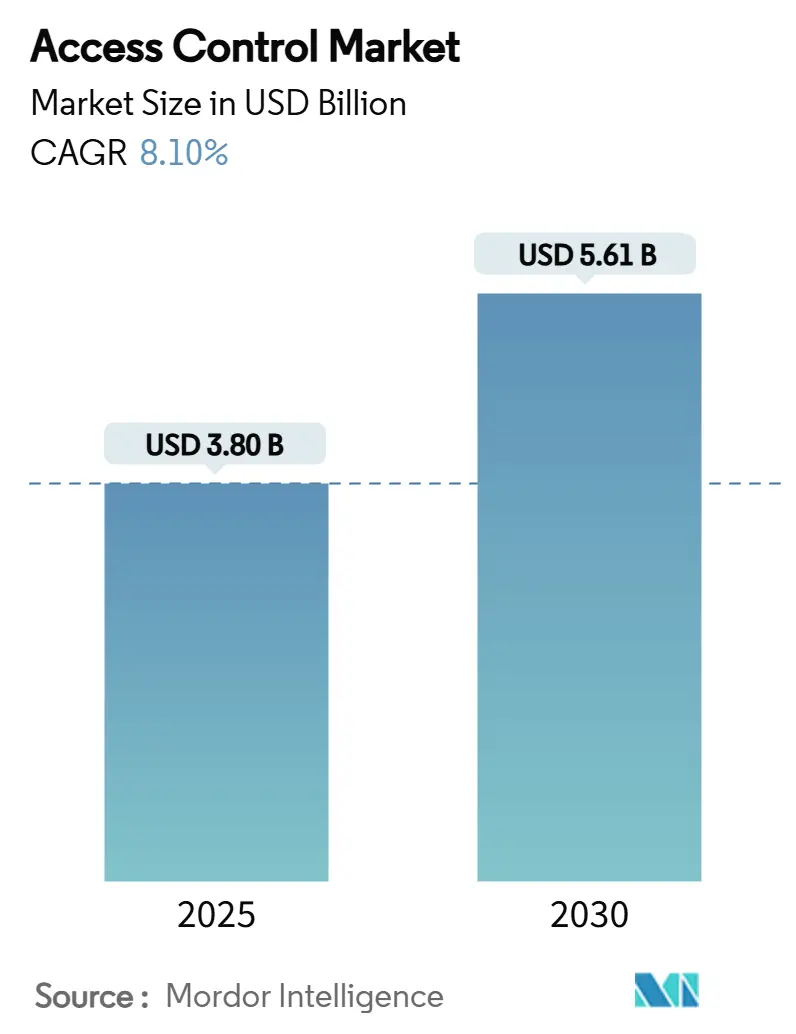
Access Control Market Analysis by Mordor Intelligence
The access control market size is valued at USD 3.80 billion in 2025 and is projected to reach USD 5.61 billion by 2030, registering an 8.10% CAGR over the forecast period. Demand is intensifying as cloud management, mobile credentials and biometrics replace legacy keys and cards across corporate, public-sector and critical-infrastructure facilities. Stricter data-protection regulations, the premium placed on contactless user experiences and convergence with video surveillance are reinforcing the upgrade cycle. Price escalations linked to semiconductor shortages are nudging buyers toward software-defined architectures that future-proof capital expenditure while mitigating supply-chain risk.
Key Report Takeaways
- By component, hardware led with 62.1% revenue share in 2024; software is forecast to expand at a 9.1% CAGR to 2030.
- By ACaaS deployment, hosted models captured 52.3% of the access control market share in 2024, while hybrid ACaaS is projected to grow at 8.8% CAGR through 2030.
- By authentication method, single-factor systems held 64.5% share in 2024; mobile credential technologies are advancing at an 8.2% CAGR.
- By connectivity, RFID/NFC retained 58.3% share in 2024; ultra-wideband solutions are scaling at 8.6% CAGR.
- By end-user, commercial buildings led with 31.7% of access control market size in 2024; healthcare facilities are expanding at 8.8% CAGR.
- Regionally, North America commanded 38.9% share in 2024; the Middle East is growing the fastest at 9.6% CAGR through 2030.
Global Access Control Market Trends and Insights
Drivers Impact Analysis
| Driver | (~) % Impact on CAGR Forecast | Geographic Relevance | Impact Timeline |
|---|---|---|---|
| Regulatory Mandates for Electronic Access in GDPR-Sensitive EU Data Centers | +1.8% | Europe, with spillover to North America | Medium term (2-4 years) |
| Contactless Mobile Credential Uptake in North American Corporate Real-Estate | +1.5% | North America, expanding to Asia-Pacific | Short term (≤ 2 years) |
| Smart-City and Critical-Infrastructure Programs Boosting Biometrics in the Middle East | +1.2% | Middle East, with early adoption in UAE and Saudi Arabia | Long term (≥ 4 years) |
| Expansion of APAC Co-working Spaces Driving Cloud-Based ACaaS | +1.0% | Asia-Pacific core, with spillover to global markets | Medium term (2-4 years) |
| IP Video–Access Control Convergence Upgrades at European Transport Hubs | +0.9% | Europe, with selective adoption in North America | Medium term (2-4 years) |
| Retrofit Demand from Ageing Key-Card Systems in US Higher-Education | +0.8% | North America, with similar trends in developed markets | Short term (≤ 2 years) |
| Source: Mordor Intelligence | |||
Regulatory Mandates for Electronic Access in GDPR-Sensitive EU Data Centers
The NIS2 directive, effective October 2024, requires multi-factor authentication and tamper-resistant audit trails across every physical entry point. Data-center operators are accelerating migration from legacy cards to biometric or mobile credentials to meet encryption and continuous-monitoring clauses. Vendor supply-chain scrutiny raises procurement thresholds, steering demand toward platforms offering automated compliance reporting. Synergies between NIS2 and GDPR are creating a premium for unified solutions that protect personal data while enforcing physical security, lifting overall replacement budgets across the access control market.[1]Cisco, “Products – NIS2 Compliance for Industries White Paper,” cisco.com
Contactless Mobile Credential Uptake in North American Corporate Real-Estate
Commercial landlords are issuing Apple Wallet and Google Pay credentials that unlock turnstiles, elevators and suites without physical interaction. Remote provisioning cuts badge issuance costs and supports flexible seating policies. Encrypted over-the-air updates let facility teams deactivate lost phones instantly, tightening security while enhancing tenant experience. The solution’s compatibility with existing smartphone infrastructure eliminates card-printer overheads, strengthening its business case. Fast deployment cycles translate into visible gains in operational efficiency, reinforcing momentum for the access control market.[2]Soloinsight, “Mobile Credentials,” soloinsight.com
Smart-City and Critical-Infrastructure Programs Boosting Biometrics in the Middle East
The UAE’s plan to replace physical IDs with nationwide biometric verification is catalyzing large-scale facial and iris systems across government, healthcare and transportation campuses. Saudi Arabia’s border-control upgrade processes 120,000 fingerprint transactions daily, underscoring regional appetite for high-throughput biometric access. These flagship projects have lowered risk perception around multi-modal biometrics, encouraging private developers to adopt similar solutions. Favorable regulatory stances that prioritize security over privacy speed procurement, positioning the Middle East as an innovation sandbox that influences global access control market specifications.
Expansion of APAC Co-working Spaces Driving Cloud-Based ACaaS
Rising flexible-workspace penetration across South Korea, Japan and India demands scalable, subscription-driven access control as a service that automates member onboarding and billing synchronously with booking apps. [3]Airfob, “Why Access Control is the Secret to Coworking Profitability in the UK?” airfob.com Hosted ACaaS eliminates server ownership, lowering capex for operators opening multiple locations in rapid succession. Real-time utilization analytics feed dynamic pricing models, reinforcing revenue management. Hybrid deployments that cache credentials locally satisfy data-sovereignty regulations while preserving cloud analytics, widening enterprise adoption. This use case keeps the access control market on a steady upward curve, particularly among technology-savvy founders.
Restraints Impact Analysis
| Restraint | (~) % Impact on CAGR Forecast | Geographic Relevance | Impact Timeline |
|---|---|---|---|
| Cyber-Security Compliance Costs for EU Cloud Deployments (NIS2) | -1.2% | Europe, with regulatory spillover effects | Medium term (2-4 years) |
| Secure MCU Chip Shortages Affecting Reader Shipments | -0.9% | Global, with acute impact in Asia-Pacific manufacturing | Short term (≤ 2 years) |
| Privacy Pushback on Facial Recognition in US and EU States | -0.8% | North America and Europe | Long term (≥ 4 years) |
| SME Budget Constraints in South America | -0.6% | South America, with selective impact in other emerging markets | Medium term (2-4 years) |
| Source: Mordor Intelligence | |||
Cyber-Security Compliance Costs for EU Cloud Deployments (NIS2)
Cloud-hosted access platforms must add continuous threat-monitoring, secure code-signing and documented development pipelines to satisfy NIS2, lifting vendor operating costs by 15–20%. Small providers struggle to absorb audit fees and penetration-test expenses, triggering consolidation as buyers gravitate toward global brands with certified infrastructure. Some EU enterprises defer upgrades, stretching the replacement cycle, which marginally tempers the access control market growth outlook.
Secure MCU Chip Shortages Affecting Reader Shipments
Tight supply of cryptographic MCUs extends lead times for biometric and multi-tech readers to 16 weeks, prompting OEM list-price increases of 3.5-15%. ASSA ABLOY raised electronic product prices 9.9% in 2024 to offset component inflation. Project delays erode installer margins and complicate budgeting for education and healthcare clients. Accelerated redesigns around alternative chips divert engineering resources from innovation pipelines, modestly suppressing near-term access control market expansion.
Segment Analysis
By Component: Software Innovation Drives Hardware Dominance
Hardware led 2024 revenue with 62.1% share, reflecting the essential need for electronic locks, controllers and biometric readers in physical deployments. University retrofits alone drove substantial lock refresh cycles as campuses shifted to mobile-ready infrastructure. Electronic locks posted the fastest unit growth, powered by ultra-wideband modules that enable hands-free entry. Biometric multi-sensor readers gained traction in laboratories and pharmacies demanding high-assurance verification.
Software is growing at 9.1% CAGR to 2030, adding predictive analytics and AI-driven anomaly detection to management consoles. Cloud control planes unify disparate sites, allowing real-time policy pushes and automated compliance audits. Video-access convergence within dashboards strengthens investigative capabilities, while open APIs invite ecosystem development. Integration services and recurring support contracts widen partner revenue, positioning managed services as a resilient annuity layer within the access control industry.
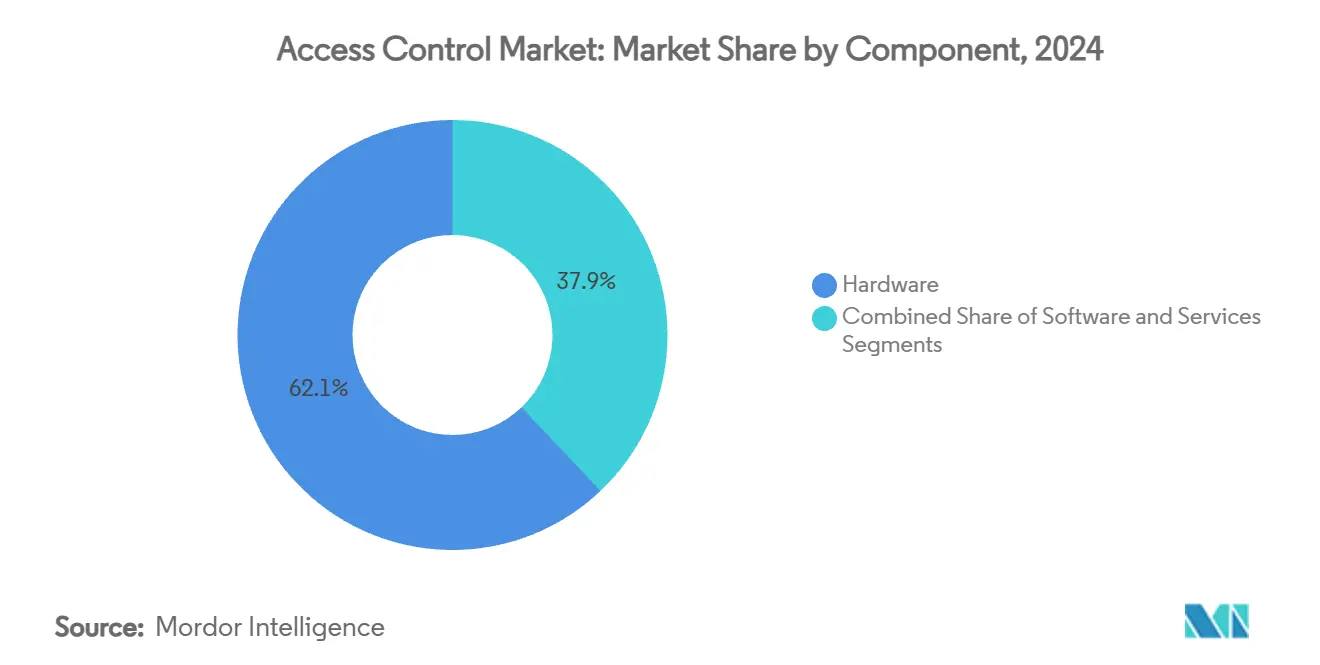
Note: Segment shares of all individual segments available upon report purchase
By ACaaS Deployment: Hybrid Models Gain Enterprise Traction
Hosted ACaaS controlled 52.3% of 2024 deployments, driven by SMEs favoring predictable subscriptions over server ownership. Feature parity with on-prem solutions, plus automatic updates, reduces the skills burden for lean IT departments. Granular tenant portals help co-working brands manage thousands of members dynamically, deepening customer loyalty within the access control market.
Hybrid ACaaS is the fastest-growing model at 8.8% CAGR, balancing cloud orchestration with local edge storage for regulated entities. Hospitals route sensitive logs to on-site appliances during network outages, then synchronize to the cloud for analytics once connectivity returns. Managed ACaaS retains a niche for complex, multi-vendor estates needing bespoke integrations, but platforms are steadily converging toward self-service paradigms that scale across sectors in the wider access control market.
By Authentication Method: Mobile Credentials Challenge Single-Factor Dominance
Single-factor systems still hold 64.5% adoption through widespread key cards and numeric pads catering to basic perimeter security. However, regulatory pressures and high-profile breaches expose their limitations. Replacement cycles accelerate in finance, pharma and critical infrastructure where tamper evidencing and traceability are paramount.
Mobile credentials packaged inside Apple Wallet or Google Pay are rising at 8.2% CAGR, delivering encrypted Bluetooth and NFC exchanges that resist cloning. Administrators provision or revoke rights instantly over the air, lowering operational cost per user. Multi-factor deployments layering biometrics atop mobile IDs deliver frictionless yet strong authentication, steering the overall access control market toward converged identity paradigms.
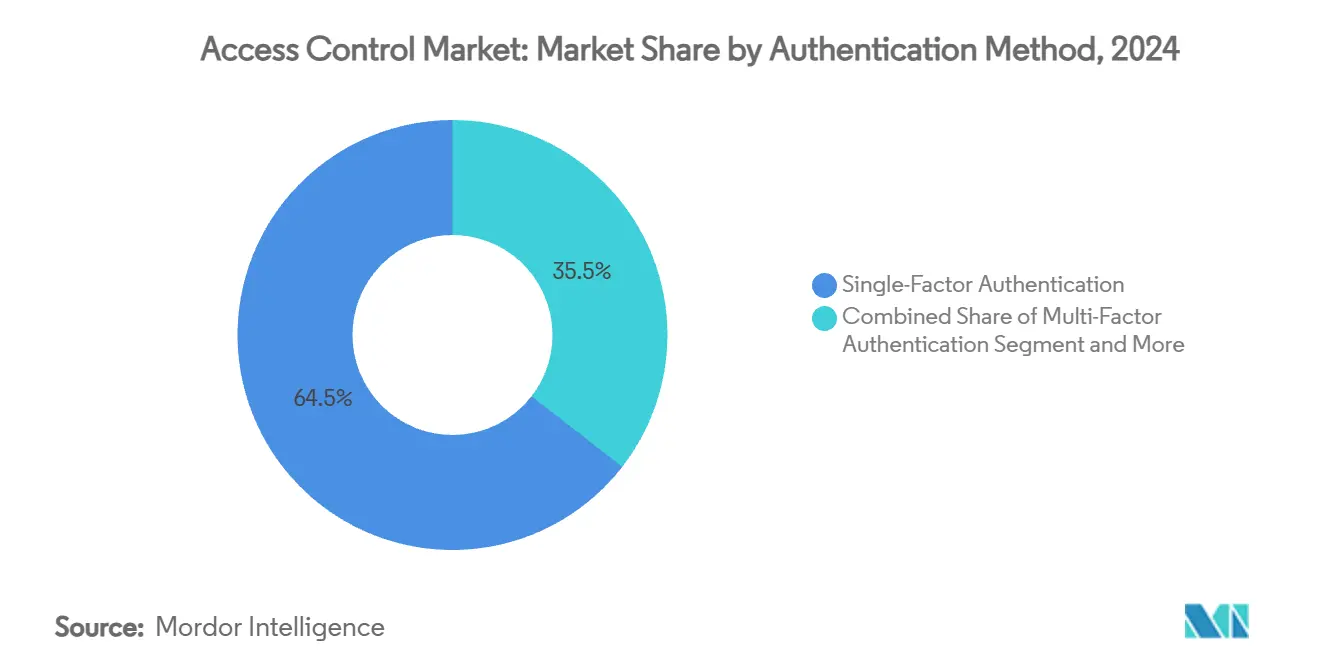
Note: Segment shares of all individual segments available upon report purchase
By End-User Vertical: Healthcare Drives Fastest Growth
Commercial facilities generated 31.7% of access control market size in 2024 as landlords aligned security upgrades with sustainability retrofits. Integrated mobile access and space-analytics tools optimize tenant engagement while lowering badge issuance toil.
Healthcare settings, posting 8.8% CAGR, implement role-based permissions for pharmacies, operating theaters and record rooms in line with HIPAA policy. Contactless biometrics support infection-control regimes, while emergency lockdown features enhance threat response. Industrial, government and transport hubs maintain specialized demand for ruggedized, OT-friendly readers, sustaining long-tail growth for the broader access control market.
Geography Analysis
North America maintained 38.9% 2024 revenue share underpinned by large-scale modernizations in corporate campuses, universities and hospitals. US higher-education retrofits, such as the University of Kentucky’s 9,000-door conversion, illustrate campus-wide embrace of mobile-ready platforms that blend access control with attendance analytics. Canada’s smart-building incentives and Mexico’s cross-border logistics facilities add incremental demand. Venture investment in UWB and biometric startups keeps the region at the forefront of technology innovation within the access control market.
The Middle East is the fastest-growing territory at 9.6% CAGR through 2030, lifted by sovereign smart-city agendas and security-first regulatory frameworks. UAE and Saudi Arabia demonstrate large-scale rollouts of facial, iris and fingerprint systems that replace physical IDs, while Qatar and Oman embed access control into nationwide IoT command centers. Local integrators build on global vendor SDKs, creating region-specific solutions that accelerate market localization.
Europe exhibits steady growth despite stringent privacy legislation. NIS2 and the EU AI Act require explicit consent and transparency for biometric use. Organizations respond by adopting hybrid ACaaS so that sensitive biometric templates remain on European soil. Germany, France and the UK prioritize open-protocol systems to avoid vendor lock-in, while Nordic operators pioneer sustainable, low-power readers. Eastern European transport hubs upgrade card-based barriers with mobile and video-verified entry, all contributing to incremental access control market revenue.
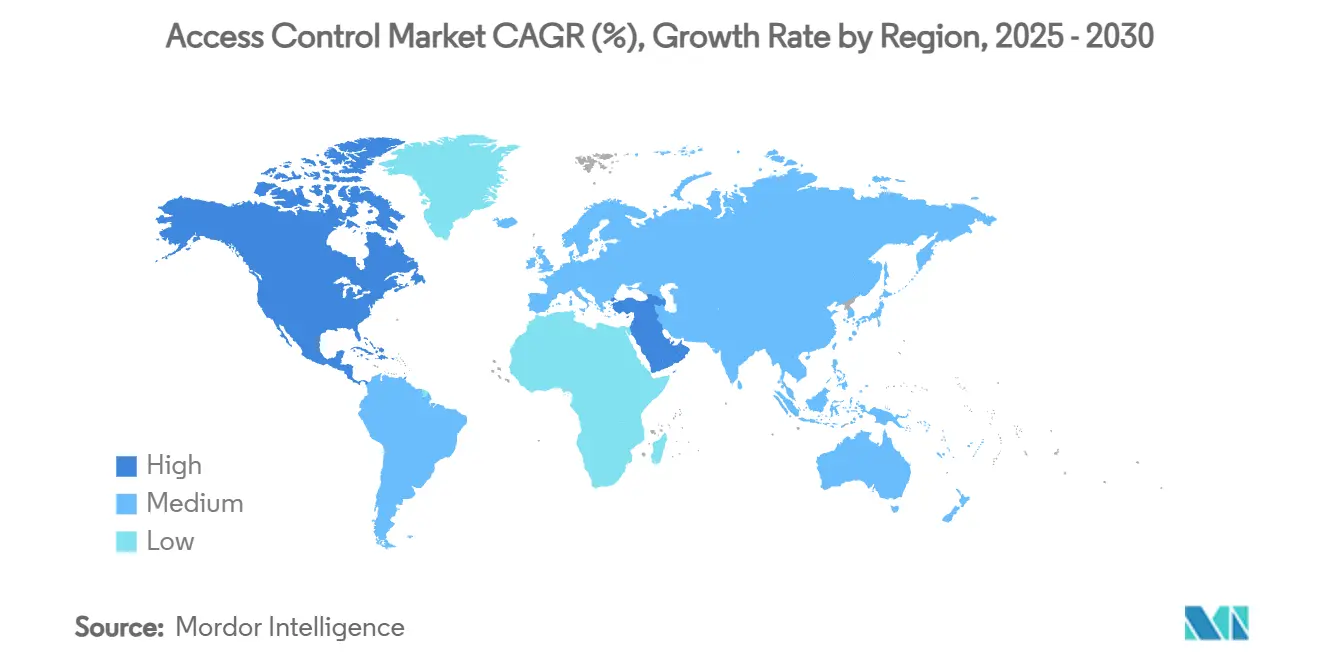
Competitive Landscape
The market remains moderately fragmented, yet consolidation momentum is clear as leading manufacturers deepen vertical integration. Honeywell’s USD 4.95 billion purchase of Carrier’s Global Access Solutions unit in 2024 delivered LenelS2, Onity and Supra brands, boosting annual sales by USD 1 billion. ASSA ABLOY followed with successive acquisitions of SKIDATA, 3millID and Third Millennium, broadening reader portfolios and parking-access capabilities.
Strategic alliances reinforce technology differentiation. Allegion spearheaded the Aliro mobile-access protocol with the Connectivity Standards Alliance to foster interoperability and lock in smartphone ecosystems. The FiRa Consortium unites chipset, handset and lock vendors around UWB secure ranging standards, reducing integration friction and accelerating premium-tier deployments.
Financial results confirm pivot toward electronic and software revenues. Allegion’s Q1 2025 Americas segment grew 5.4% on strong electronic access uptake. Dormakaba delivered 4.9% organic Access Solutions growth by optimizing pricing amid component inflation. Vendors funnel expanded gross profit into AI, edge computing and privacy-by-design R&D, setting the competitive tone for the access control market.
Access Control Industry Leaders
-
Suprema Inc.
-
Hanwha Techwin Co. Ltd
-
Thales Group (Gemalto NV)
-
Bosch Security System Inc.
-
Honeywell International Inc
- *Disclaimer: Major Players sorted in no particular order
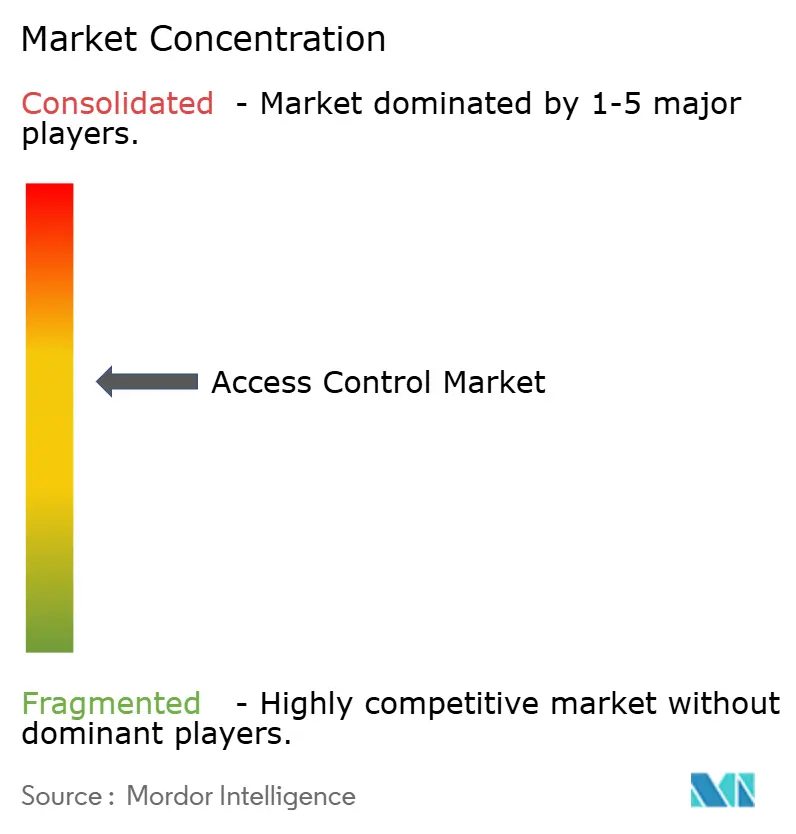
Recent Industry Developments
- February 2025: ASSA ABLOY acquired 3millID and Third Millennium for USD 21 million, strengthening enterprise reader technology and expanding US-UK channel reach.
- January 2025: Schlage launched the Sense Pro Smart Deadbolt with ultra-wideband hands-free unlocking and Apple Home Key compatibility.
- January 2025: ASSA ABLOY unveiled Centrios, a subscription platform for small-business access control supporting 50 devices and 200 users.
- November 2024: Johnson Controls introduced C•CURE Cloud, adding SOC 2-compliant off-prem infrastructure monitoring to its security suite.
Global Access Control Market Report Scope
Access control products allow the end-users to authenticate the personnel accessing an organization's physical infrastructure. Securing a location, such as a building, parking lot, or office space, is known as physical access control. A physical access control system (PACS) is frequently installed to oversee and enforce physical security. PACS shields areas of a building or its grounds from unauthorized access.
The access control market is segmented by type (card reader & access control devices (card-based, proximity, smart card (contact and contactless)), biometric readers, electronic locks, and software), end-user vertical (commercial, residential, government, industrial, transport & logistics, healthcare, and military & defense) and geography(North America (United States, Canada), Europe (United Kingdom, Germany, France, Rest of Europe), Asia Pacific (China, Japan, India, South Korea, Rest of Asia Pacific), and the rest of the world). The market sizes and forecasts are provided in terms of value (USD) for all the segments.
| Hardware | Card / Proximity / Smart-card Readers |
| Biometric Readers (Fingerprint, Face, Iris, Multimodal) | |
| Electronic Locks (Magnetic, Electric Strike, Deadbolt, Wireless Smart Lock) | |
| Controllers and Panels | |
| Software | Access Control Management Suites |
| Video Management Integration Plug-ins | |
| Services | Installation and Integration |
| Support and Maintenance |
| Hosted ACaaS |
| Managed ACaaS |
| Hybrid ACaaS |
| Single-Factor Authentication |
| Multi-Factor Authentication |
| Mobile Credential / Bluetooth LE |
| RFID / NFC |
| Smart Cards (125 kHz, 13.56 MHz) |
| Bluetooth Low Energy |
| Ultra-Wideband (UWB) |
| Commercial Buildings |
| Industrial and Manufacturing |
| Government and Public Sector |
| Transport and Logistics |
| Healthcare Facilities |
| Military and Defense Installations |
| Residential and Smart Homes |
| North America | United States | |
| Canada | ||
| Mexico | ||
| South America | Brazil | |
| Argentina | ||
| Rest of South America | ||
| Europe | United Kingdom | |
| Germany | ||
| France | ||
| Italy | ||
| Spain | ||
| Rest of Europe | ||
| Asia-Pacific | China | |
| Japan | ||
| India | ||
| South Korea | ||
| ASEAN | ||
| Australia | ||
| New Zealand | ||
| Rest of Asia-Pacific | ||
| Middle East and Africa | Middle East | GCC |
| Turkey | ||
| Israel | ||
| Rest of Middle East | ||
| Africa | South Africa | |
| Nigeria | ||
| Egypt | ||
| Rest of Africa | ||
| By Component | Hardware | Card / Proximity / Smart-card Readers | |
| Biometric Readers (Fingerprint, Face, Iris, Multimodal) | |||
| Electronic Locks (Magnetic, Electric Strike, Deadbolt, Wireless Smart Lock) | |||
| Controllers and Panels | |||
| Software | Access Control Management Suites | ||
| Video Management Integration Plug-ins | |||
| Services | Installation and Integration | ||
| Support and Maintenance | |||
| By Access Control-as-a-Service (Deployment) | Hosted ACaaS | ||
| Managed ACaaS | |||
| Hybrid ACaaS | |||
| By Authentication Method | Single-Factor Authentication | ||
| Multi-Factor Authentication | |||
| Mobile Credential / Bluetooth LE | |||
| By Connectivity Technology | RFID / NFC | ||
| Smart Cards (125 kHz, 13.56 MHz) | |||
| Bluetooth Low Energy | |||
| Ultra-Wideband (UWB) | |||
| By End-User Vertical | Commercial Buildings | ||
| Industrial and Manufacturing | |||
| Government and Public Sector | |||
| Transport and Logistics | |||
| Healthcare Facilities | |||
| Military and Defense Installations | |||
| Residential and Smart Homes | |||
| By Geography | North America | United States | |
| Canada | |||
| Mexico | |||
| South America | Brazil | ||
| Argentina | |||
| Rest of South America | |||
| Europe | United Kingdom | ||
| Germany | |||
| France | |||
| Italy | |||
| Spain | |||
| Rest of Europe | |||
| Asia-Pacific | China | ||
| Japan | |||
| India | |||
| South Korea | |||
| ASEAN | |||
| Australia | |||
| New Zealand | |||
| Rest of Asia-Pacific | |||
| Middle East and Africa | Middle East | GCC | |
| Turkey | |||
| Israel | |||
| Rest of Middle East | |||
| Africa | South Africa | ||
| Nigeria | |||
| Egypt | |||
| Rest of Africa | |||
Key Questions Answered in the Report
What is the current size of the access control market and its growth outlook?
The global access control market size stands at USD 3.80 billion in 2025 and is forecast to reach USD 5.61 billion by 2030 at an 8.10% CAGR.
Which region is expanding the fastest?
The Middle East is projected to grow at a 9.6% CAGR through 2030, driven by government-backed biometric programs and smart-city investments.
Why are mobile credentials gaining traction?
Mobile IDs eliminate physical card management, enable encrypted over-the-air provisioning and align with hybrid work patterns, supporting an 8.2% CAGR adoption rate.
How are semiconductor shortages affecting the market?
Secure MCU constraints are extending reader lead times to 16 weeks and have triggered 3.5-15% price increases, moderating short-term hardware growth.
Page last updated on:
